How to Prevent Mold In Your Basement
A Professional Inspector’s Complete Guide
Mold is a persistent threat in Canadian basements, with mold spores constantly searching for the perfect conditions to establish colonies. Through our 15,000+ basement inspections across Ontario and Quebec, we’ve identified the critical factors that determine whether your basement becomes a mold-free environment or a breeding ground for dangerous toxic mold growth.
Preventing mold growth in your basement requires understanding the science behind mold development and implementing proven strategies that address both immediate risks and long-term protection. Whether you’re dealing with existing moisture issues or want to prevent basement mold before it starts, this comprehensive guide provides professional insights gained from nearly two decades of field experience.
Your basement faces unique challenges in the Canadian climate. Mold thrives in environments with adequate moisture, organic material, and oxygen – conditions that Canadian basements frequently provide due to foundation water intrusion, seasonal humidity fluctuations, and inadequate ventilation systems.
Even when your basement appears dry, mold could be developing behind walls, underneath flooring, or within HVAC systems. In our experience, 92% of basements we inspect show some evidence of mold presence, often in areas homeowners never suspected.
What Causes Mold to Grow in Basements?
Mold grows in basements when three conditions combine: moisture levels above 60%, organic materials like wood or drywall, and adequate oxygen. Canadian basements face unique challenges from freeze-thaw cycles, spring snowmelt, and summer humidity spikes that create persistent moisture problems leading to dangerous mold development.
What Humidity Level Prevents Mold in Basement?
Maintain basement humidity between 30-50% year-round to prevent mold growth. Professional dehumidifiers should target 45% relative humidity as the optimal level. During Canadian summers, humidity often spikes above 70%, requiring active dehumidification to maintain safe levels and prevent condensation on cold surfaces.
🍁 Understanding the Canadian Basement Mold Challenge
Canadian basements face specific environmental pressures that create ideal mold conditions. Freeze-thaw cycles throughout winter create foundation stress and potential water entry points. Spring snowmelt and seasonal flooding events saturate soil around foundations. Summer humidity spikes combined with cool basement temperatures create persistent condensation issues.
Since moisture is the primary catalyst for mold growth – whether from external water intrusion, internal humidity buildup, or inadequate moisture management – developing a comprehensive prevention strategy is essential for maintaining healthy indoor air quality.
If you’ve already identified suspicious growth patterns or experienced water damage events, professional assessment is crucial. Contact our mold experts for comprehensive mold inspection services to determine whether prevention strategies are sufficient or if active mold remediation is required.
For residents throughout our service areas, we provide specialized mold inspection in Montreal and comprehensive mold inspection and testing in Ottawa, utilizing advanced diagnostic equipment to detect moisture intrusion and mold development before visible growth occurs.
Worried About Basement Mold? Get a Free Inspection!
Basements are prone to mold and mildew growth due to excess moisture from leaks, condensation, or flooding. Don’t let hidden mold impact your health and safety. Contact Mold Busters for a free virtual mold inspection. Our experts provide a thorough assessment and actionable plan to keep your basement mold-free. Act now to safeguard your home!
🔎 Early Warning Signs: Professional Detection Methods
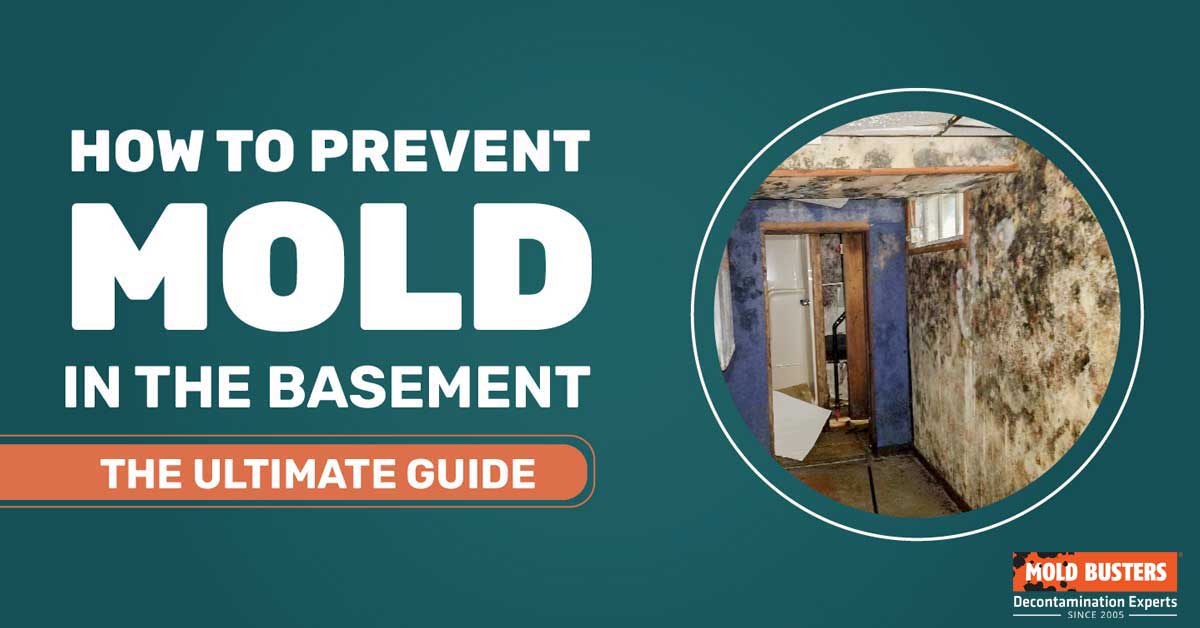
Based on our extensive inspection experience, successful mold prevention begins with recognizing early warning indicators before visible growth develops. Professional inspectors utilize multiple detection methods to identify mold-favorable conditions:
Sensory Detection Methods:
- ▸ Musty odors – Often the first indicator of hidden mold colonies
- ▸ Visible growth patterns – Including both obvious mold and subtle discoloration
- ▸ Water staining on foundation walls, indicating moisture intrusion pathways
- ▸ Material deterioration – Peeling paint, warping wood, or crumbling drywall
- ▸ Persistent condensation on cold surfaces like pipes, windows, or metal fixtures
Recognizing these early indicators prevents the progression from minor moisture issues to extensive black mold contamination. Our inspection experience across Ottawa, Montreal, and surrounding areas shows that homeowners who identify mold odors early can often prevent major structural damage and costly remediation.
Professional mold testing services can confirm suspected contamination and identify specific mold species present in your basement environment. This information guides targeted prevention strategies and helps determine appropriate intervention levels.
🔬 Professional-Grade Detection Tools:
- ▸Infrared thermography reveals moisture patterns invisible to visual inspection
- ▸ Equilibrium relative humidity testing identifies moisture content within building materials
- ▸ Air sampling analysis detects airborne spore concentrations before visible growth
- ▸Surface sampling confirms species identification and concentration levels
💦 Root Causes: Why Canadian Basements Develop Mold
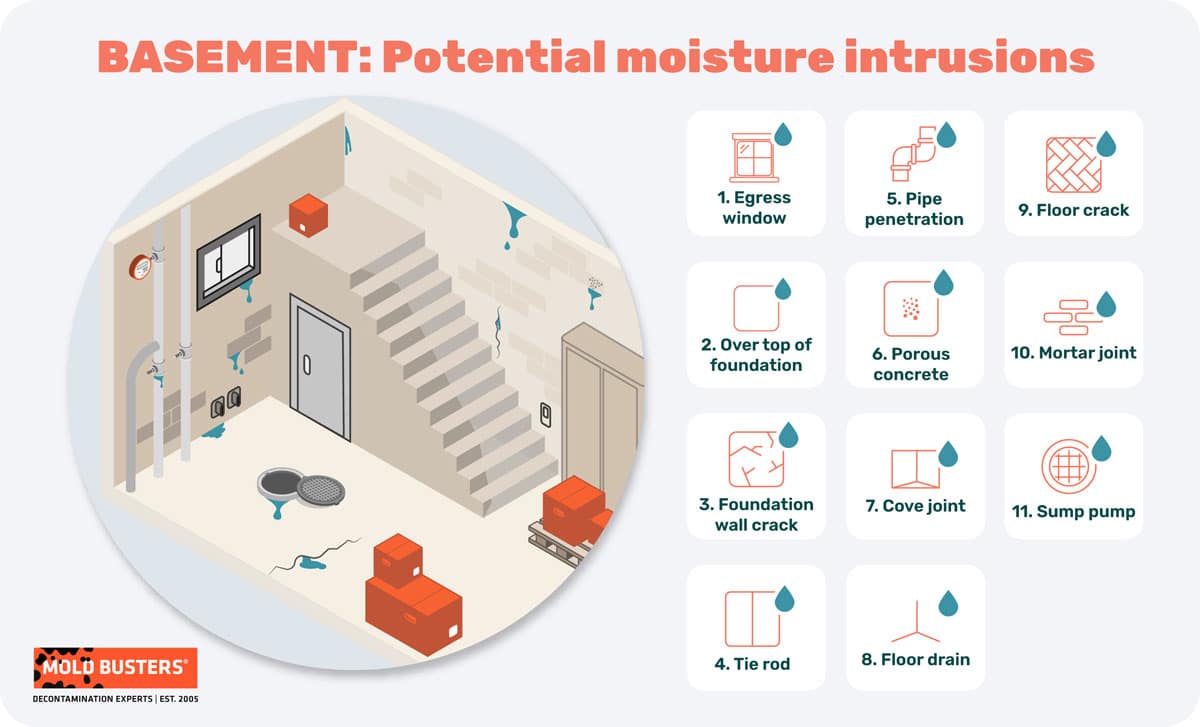
Through thousands of basement inspections, we’ve identified that successful mold prevention requires addressing both external moisture sources and internal humidity generation. Understanding these causes of mold helps homeowners implement targeted prevention strategies:
🌧 External Moisture Sources:
- ▸ Foundation water intrusion through cracks, joints, or porous concrete
- ▸ Groundwater infiltration during seasonal high water table periods
- ▸ Surface water collection from inadequate drainage or grading issues
- ▸ Basement flooding events from storm surge, sewer backup, or equipment failure
- ▸ Window well leakage through deteriorated seals or inadequate drainage
💨 Internal Humidity Generation:
- ▸ Daily activities producing 12-15 pounds of water vapor per day in typical households
- ▸ Unvented appliances including dryers, water heaters, or humidification systems
- ▸ Inadequate ventilation allowing humidity accumulation without removal pathways
- ▸ Temperature differentials creating condensation on cold surfaces
- ▸ Stored organic materials releasing moisture through natural decomposition

Did you know?
Only 8% of basements we have tested didn’t have presence of mold?! Find out more exciting mold stats and facts inside our mold statistics page.
When Should I Call a Professional for Basement Mold?
Contact professional mold experts immediately when visible mold covers more than 10 square feet (EPA threshold), persistent musty odors remain despite cleaning, or health symptoms like respiratory issues develop. Professional intervention is also required for HVAC contamination, recent flooding, or structural water damage situations.
Will a Dehumidifier Prevent Basement Mold?
Yes, properly sized dehumidifiers prevent basement mold by maintaining humidity below 60%. Canadian basements require 70+ pint capacity units for spaces under 1,000 square feet. Professional-grade dehumidifiers with continuous drainage and low-temperature operation are essential for year-round moisture control and mold prevention.
How to Tell if You Have Mold in Your Basement
Basement mold signs include persistent musty odors, visible black or green spots on walls, white fuzzy growth on organic materials, water stains, and condensation on pipes or windows. Professional thermal imaging can detect hidden moisture patterns behind walls where mold develops before becoming visible.
How Often Should I Inspect My Basement for Mold?
Inspect your basement monthly for mold signs including moisture, odors, and visible growth. Professional inspections should occur annually or after water damage events. Canadian homeowners should increase inspections during spring snowmelt (March-May) and summer humidity peaks (June-August) when mold risks are highest.
🛡 Professional Prevention Strategy: The 7-Step System

Based on our field experience across Ontario and Quebec, effective basement mold prevention requires systematic implementation of moisture control measures. Our proven 7-step prevention system addresses both immediate threats and long-term environmental management:
- ▸ Establish comprehensive moisture monitoring using professional-grade hygrometers and data logging systems
- ▸ Implement active humidity control through properly sized dehumidification equipment
- ▸ Seal foundation penetrations and address structural water intrusion pathways
- ▸ Optimize drainage systems to direct water away from foundation perimeters
- ▸ Upgrade ventilation capacity to ensure adequate air exchange and circulation
- ▸ Apply waterproof barrier systems to vulnerable surfaces and materials
- ▸ Maintain consistent inspection schedules for early problem detection and intervention
External Water Management: Foundation Protection
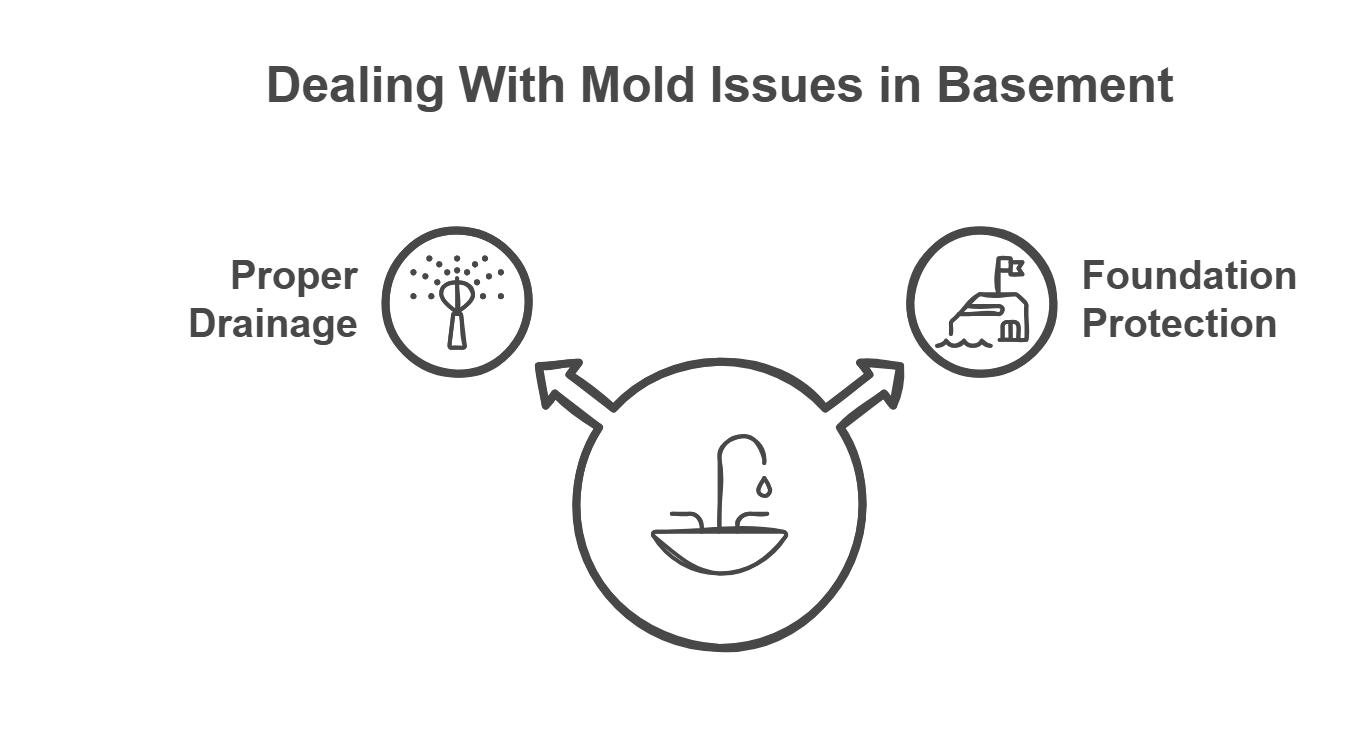
Drainage System Optimization
Professional exterior water management requires systematic approach to foundation protection:
🌊 Surface Drainage Management:
- ▸ Grade establishment – Maintain 6-inch drop over first 10 feet from foundation
- ▸ Gutter system maintenance – Clean quarterly and inspect for proper water flow
- ▸ Downspout extension – Direct water minimum 6 feet from foundation walls
- ▸ Window well protection – Install proper drainage and waterproof barriers
- ▸ Landscape water management – Avoid irrigation near foundation areas
🛡 Foundation Waterproofing Systems:
- ▸ Crack injection using polyurethane or epoxy sealants for active leaks
- ▸ Exterior membrane application on accessible foundation walls
- ▸ French drain installation for persistent groundwater pressure
- ▸ Foundation coating using waterproof sealants rated for below-grade application
- ▸ Regular inspection protocols to identify developing issues before major water intrusion
🔧 Professional vs DIY Assessment
Through our inspection experience, we’ve developed clear guidelines for determining appropriate intervention levels:
✅ DIY-Appropriate Tasks:
- ▸ Surface crack sealing (less than 1/8 inch width)
- ▸ Gutter cleaning and basic maintenance
- ▸ Downspout extension installation
- ▸ Basic caulking around windows and penetrations
- ▸ Surface grade adjustments under 12 inches
⚡ Professional Intervention Required:
- ▸ Active water infiltration through foundation walls
- ▸ Structural cracks wider than 1/8 inch
- ▸ Repeated basement flooding events
- ▸ Complex drainage system installation
- ▸ Foundation excavation or major waterproofing projects
How Much Does Basement Mold Prevention Cost?
DIY basement mold prevention costs $200-800 including dehumidifier, moisture meters, and sealing materials. Professional waterproofing ranges $2,000-8,000 depending on basement size and water intrusion severity. Professional mold prevention assessment costs $300-500 but prevents remediation expenses of $3,000-15,000+ for established infestations.
What Temperature Prevents Mold in Basement?
Maintain basement temperatures above 15°C (59°F) to prevent condensation and mold growth. Consistent temperatures between 18-21°C (64-70°F) are optimal for Canadian basements. Temperature fluctuations create condensation on cold surfaces, providing moisture for mold development even with proper humidity control.
🌡 Advanced Humidity Control Systems
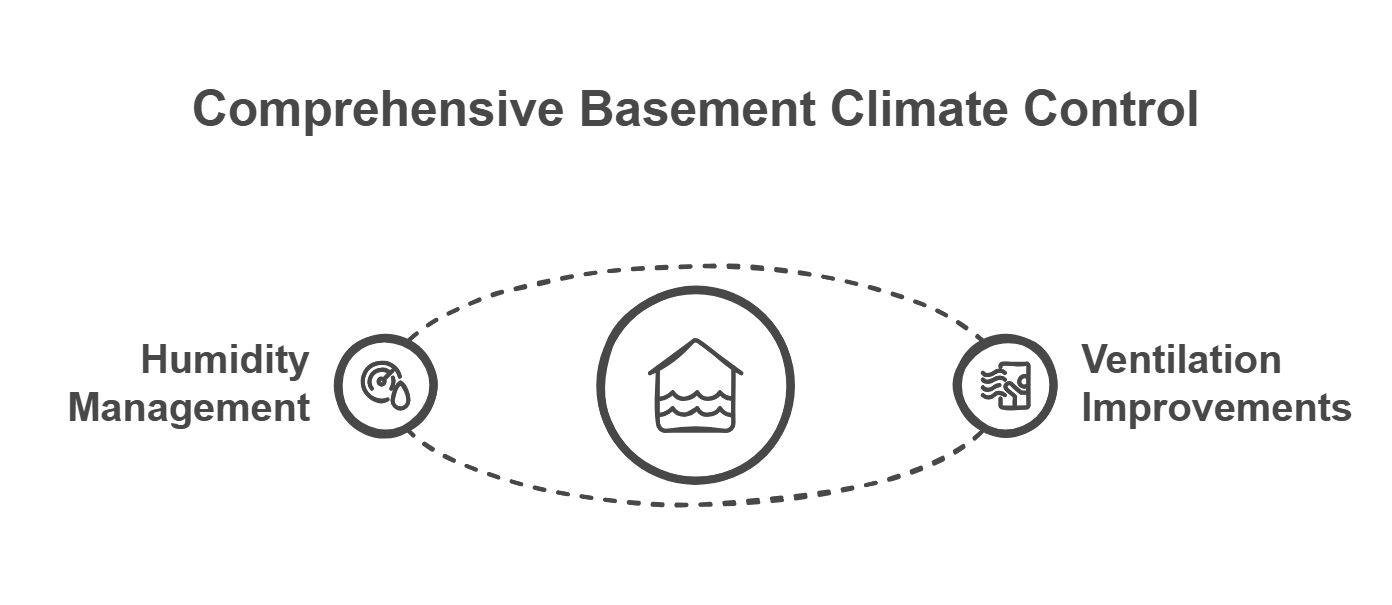
💨 Mechanical Ventilation Solutions
Effective basement humidity control requires understanding the relationship between air exchange, temperature management, and moisture removal capacity:
🍃 Natural Ventilation Optimization:
- ▸ Cross-ventilation establishment using strategically placed openings
- ▸ Stack effect utilization for natural air movement in multi-level basements
- ▸ Window operation scheduling based on outdoor humidity conditions
- ▸ Door positioning to encourage airflow throughout basement spaces
⚙ Mechanical Ventilation Systems:
- ▸ Exhaust fan installation with capacity ratings appropriate for basement volume
- ▸ Supply air systems to ensure adequate fresh air introduction
- ▸ Heat recovery ventilation for energy-efficient air exchange in Canadian climates
- ▸ Integrated HVAC systems providing consistent air circulation and conditioning
💧 Professional Dehumidification: Equipment and Operation
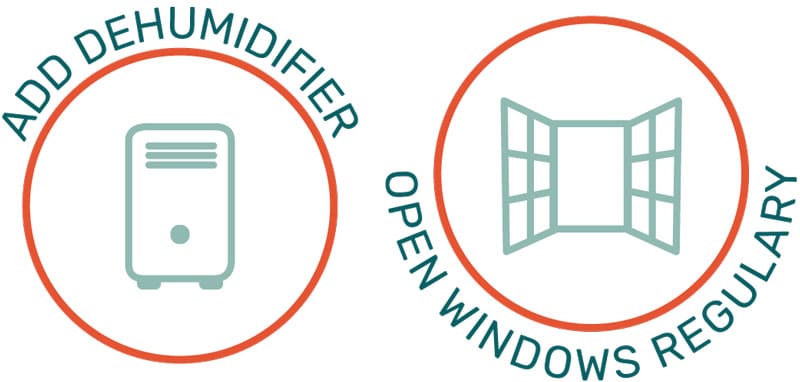
🔧 Commercial-Grade Dehumidifier Selection
Through our professional experience, we’ve identified specific equipment characteristics essential for Canadian basement environments:
📊 Capacity Requirements:
- ▸ 70-pint minimum capacity for basements under 1,000 square feet
- ▸ 100+ pint capacity for larger basements or high-moisture environments
- ▸ Continuous drainage capability with gravity feed or pump-assisted removal
- ▸ Energy efficiency ratings to minimize operating costs during extended operation periods
⭐ Professional Features:
- ▸Automatic restart capability following power interruptions
- ▸Digital humidity controls with ±2% accuracy for precise moisture management
- ▸Low-temperature operation maintaining effectiveness down to 5°C for Canadian conditions
- ▸Heavy-duty construction designed for continuous 24/7 operation
❄️ Temperature and Condensation Management
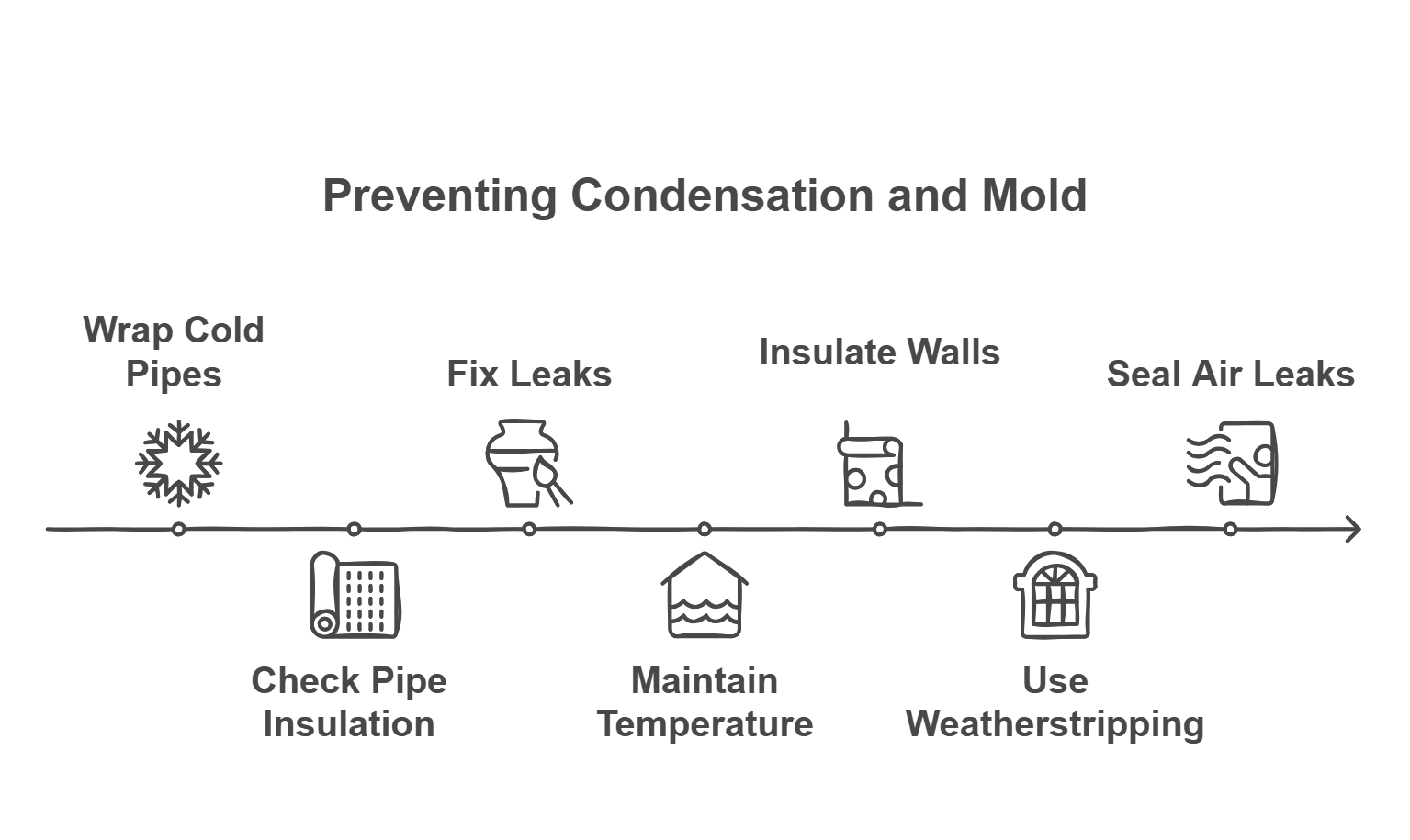
🏠 Insulation Strategy for Canadian Climates
Proper insulation prevents condensation formation on cold surfaces while maintaining energy efficiency throughout Canadian heating seasons:
🔧 Pipe Insulation Systems:
- 💙 Cold water pipe wrapping using closed-cell foam insulation
- ❤️ Hot water system protection to reduce heat loss and condensation
- 🌬️ HVAC ductwork insulation preventing condensation on cooling season surfaces
- 🔌 Penetration sealing around all pipe, cable, and utility entrances
🧱 Wall and Ceiling Insulation:
- 🛡️ Vapor barrier installation on warm side of insulation systems
- 📏 Continuous insulation coverage eliminating thermal bridging and cold spots
- 💨 Air sealing protocols preventing moisture-laden air infiltration
- 🪟 Window frame treatment to eliminate condensation formation areas
📦 Storage and Material Management

🛡️ Mold-Resistant Storage Strategies
Professional mold prevention extends beyond moisture control to include strategic material selection and storage practices:
📋 Organic Material Management:
- 📦 Cardboard elimination – Replace with plastic storage containers featuring tight-fitting lids
- 📄 Paper product protection – Store documents and books in moisture-proof containers
- 👕 Textile storage – Use vacuum-sealed bags for clothing and fabric items
- 🪑 Wood furniture treatment – Apply moisture-resistant finishes or relocate to upper levels
🌬️ Air Circulation Maintenance:
- 📏 Wall clearance requirements – Maintain 6-inch minimum clearance from exterior walls
- 🗂️ Storage organization – Arrange items to permit air circulation throughout basement
- 🏗️ Shelf systems – Use metal or plastic shelving rather than wood construction
- 🔄 Regular inventory rotation – Inspect stored items quarterly for moisture damage or mold development
🗓️ Canadian Climate Considerations: Seasonal Prevention
🌸 Spring Water Management (March-May)
Spring presents unique challenges due to snowmelt and temperature fluctuations:
- • Foundation perimeter inspection for winter damage
- • Drainage system activation and sump pump testing
- • Basement monitoring intensification during snowmelt
- • Emergency response planning for potential flooding
☀️ Summer Humidity Control (June-August)
Peak humidity seasons require enhanced moisture management:
- • Daily humidity checks during high-humidity periods
- • Dehumidifier optimization for peak load conditions
- • Ventilation adjustments based on outdoor humidity
- • Activity modifications to reduce internal moisture
🍂 Fall Winterization (September-November)
Preparation for heating season involves comprehensive system preparation:
- • Heating system inspection and calibration
- • Insulation assessment for thermal performance
- • Air sealing projects to minimize infiltration
- • Drainage system winterization
❄️ Winter Condensation Prevention (December-February)
Cold season moisture management focuses on condensation control:
- • Surface temperature monitoring for condensation
- • Humidity level adjustments for heating season
- • Ventilation balance for energy conservation
- • Ice dam prevention through proper ventilation
Best Time to Prevent Basement Mold in Canada
Begin basement mold prevention in early spring (February-March) before snowmelt creates moisture problems. Install dehumidifiers and seal water entry points before peak humidity season (June-August). Fall preparation (September-October) ensures systems are ready for heating season when condensation risks increase significantly.
Do Basement Fans Prevent Mold?
Exhaust fans help prevent basement mold by removing humid air and improving circulation. Install fans with 50+ CFM capacity per 100 square feet of basement area. Fans alone are insufficient – combine with dehumidifiers and moisture source control for complete mold prevention in Canadian basement environments.
🔧 Professional Maintenance Protocols
📋 Monthly Inspection Tasks
💧 Moisture Monitoring
- 📊 Record basement humidity levels using calibrated instruments
- 🔍 Inspect all potential water entry points including windows, foundations, and utilities
- ⚙️ Check dehumidifier operation including drainage and filter condition
- 📝 Document any changes in basement conditions or equipment performance
⚙️ System Performance Checks
- 🚰 Test sump pump operation and backup systems
- 🌬️ Inspect ventilation equipment for proper operation and airflow
- 🏠 Monitor heating/cooling system performance for efficiency and humidity control
- 🧱 Check insulation and vapor barriers for damage or deterioration
📅 Seasonal Maintenance Requirements
📆 Quarterly Tasks:
- 🔧 Professional equipment servicing for dehumidification and ventilation systems
- 💧 Drainage system inspection including exterior grading and gutter systems
- 🏗️ Foundation monitoring for new cracks, settlement, or water intrusion signs
- 🌬️ Air quality assessment using professional testing methods when indicated
📅 Annual Professional Services:
- 🔬 Comprehensive mold inspection using advanced diagnostic equipment
- 🌡️ HVAC system evaluation for humidity control effectiveness
- 🛡️ Foundation and waterproofing assessment by qualified professionals
- 🌬️ Indoor air quality testing to verify prevention strategy effectiveness
Can I Prevent Basement Mold Myself?
Homeowners can prevent basement mold through humidity control, proper ventilation, and minor sealing work. DIY prevention works for dry basements without structural water issues. Professional help is required for foundation leaks, repeated flooding, existing mold over 10 square feet, or complex drainage problems.
What Kills Mold in Basement Air?
HEPA air filtration systems remove airborne mold spores from basement environments. UV-C lights in HVAC systems kill mold spores in air circulation. However, eliminating moisture sources and maintaining proper humidity levels below 50% prevents mold growth more effectively than air treatment alone.
🚨 When to Contact Professional Mold Experts
⚡ Professional Intervention Thresholds
Based on our extensive inspection experience, specific conditions require immediate professional assessment:
🚨 Immediate Professional Consultation Required:
- 🔴 Visible mold growth covering more than 10 square feet (EPA threshold)
- 👃 Persistent musty odors despite visible cleaning and moisture control efforts
- 🤧 Health symptoms including respiratory issues, headaches, or allergic reactions
- 💧 Recent water damage from flooding, leaks, or sewage backup
- 🌬️ HVAC contamination suspected or confirmed in ductwork or equipment
⚠️ Professional Inspection Recommended:
- 🏗️ Basement renovation planning to assess hidden moisture or mold issues
- 🏡 Home purchase evaluation for potential mold and moisture problems
- 📄 Insurance claim documentation requiring professional assessment and remediation protocols
- 🔄 Recurring moisture problems despite homeowner prevention efforts
- 🏢 Complex building systems requiring specialized knowledge for effective moisture management
🏆 Mold Busters Professional Services
Our mold removal services utilize advanced diagnostic and remediation technologies developed through nearly two decades of field experience. We provide comprehensive solutions throughout Montreal and Ottawa, including specialized air quality testing to ensure complete environmental restoration.
⭐ Professional Service Advantages:
- 🔬 Advanced diagnostic equipment including thermal imaging and moisture mapping
- 📊 Comprehensive contamination assessment using air and surface sampling protocols
- 📋 Remediation protocol development tailored to specific contamination patterns and building characteristics
- ✅ Post-remediation verification ensuring complete mold removal and prevention system effectiveness
🎯 Conclusion: Long-Term Success Through Professional Prevention
Successful basement mold prevention requires understanding that moisture control is an ongoing process rather than a one-time solution. Through our 15,000+ inspections across Ontario and Quebec, we’ve learned that prevention is invariably more cost-effective than remediation, often by factors of 10:1 or greater.
The key to long-term success lies in implementing comprehensive moisture management systems that address both current conditions and future risks. Canadian basements face unique challenges from climate extremes, seasonal water intrusion, and building construction practices that require specialized knowledge and professional-grade solutions.
Regular professional assessment ensures that prevention strategies remain effective as building conditions change over time. For comprehensive mold inspection and mold testing services, trust our experienced team throughout Montreal and Ottawa to provide authoritative assessment and effective solutions.
💡 Professional consultation helps prevent major structural damage, protects family health, and maintains property values through proactive environmental management. Contact Mold Busters today to develop a customized prevention strategy based on your specific basement conditions and regional climate factors.

Get Special Gift: Industry-Standard Mold Removal Guidelines
Download the industry-standard guidelines that Mold Busters use in their own mold removal services, including news, tips and special offers:
"*" indicates required fields
Published: August 21, 2018 Updated: July 9, 2025

Written by:
John Ward
Account Executive
Mold Busters
Fact checked by:
Michael Golubev
CEO
Mold Busters
